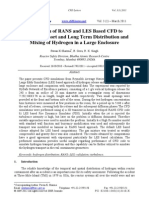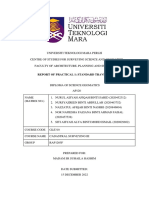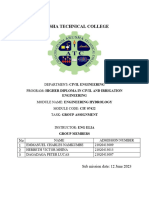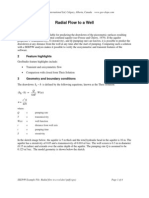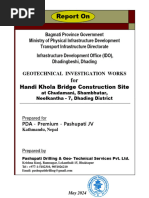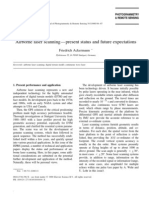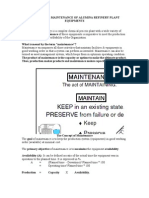Tutorial___Example_RORB_input_files.ppt
Uploaded by
Allexby C. EstardoTutorial___Example_RORB_input_files.ppt
Uploaded by
Allexby C. EstardoCatchment Water Management
CIVE1146
Tutorial – Control Vector
RMIT University©yyyy School/Department/Area 2
RMIT University©yyyy School/Department/Area 3
CONTROL VECTOR
RMIT University©yyyy School/Department/Area 4
Example - Data for the West Creek catchment
Sub catchment Areas
subcatchment A B C D E F
Area (km2) 21.8 16.9 13.7 12.7 9.8 14.8
Reach Lengths
Storage 1 2 3 4 5 6 7 8
Reach length km 4.7 4.1 3.2 2.1 2.6 3.2 2.4 4.2
RMIT University©yyyy School/Department/Area 5
UNIFORM RAINFALL DISTRIBUTION ON THE CATCHMENT
Time Rainfall (mm) Time Streamflow
(m3/sec)
0–2 0.9 0 0
2–4 2.5 2 4.57
4–6 8.7 4 9.15
6–8 1.6 6 13.7
8 – 10 5.6 8 17.2
10 – 12 6.5 10 19.9
12 23.9
14 28.0
16 22.6
18 16.9
20 10.2
22 7
24 4.57
26 2.96
28 1.61
30 0.8
32 0
RMIT University©yyyy School/Department/Area 6
• DATA FILE - FIT RUN
•
• West Creek at Jasper (Give the name of the creek and preferably location)
• 1, CHANNEL TYPE FLAG - ALL REACHES NATURAL
• 1,4.7,-99, SUB-AREA A (reach length 4.7KM)
• 3, STORE HG
• 1,4.1,-99, SUB-AREA B (reach length 4.1km)
• 4, ADD HG’s A & B
• 3, STORE SUM
• 1,3.2,-99, SUB-AREA C (reach length 3.2km)
• 4, ADD HG FROM c TO A & B
• 5,2.1,-99 ROUTE TO D INPUT (reach length 2.1 km)
• 2,2.6,-99, SUB-AREA D (reach length 2.6 km)
• 3, STORE H/G
• 1,3.2,-99, SUB-AREA E (reach length 3.2)
• 4 (ADD IN STORED H/G)
• 5,2.4,-99, ROUTE TO F INPUT (reach length 2.4km)
• 2,4.2,-99, SUB-AREA F (reach length 4.2km)
• 7.1, NOW AT THE OUTLET. COMPARE OBSERVED AND CALCULATED H/Gs.
• 0, END OF CONTROL VECTOR
• C SUB-AREA AREAS
• 21.8,16.9,13.7,12.7,9.8,14.8,-99
• 0,-99, ALL AREAS PERVIOUS
• 0900 HOURS ON 6 NOVEMBER 1971
• FIT
• C TIME INCREMENTS=2hrs, CALCULATIONS FOR 20 TIME INCREMENTS, 1 BURST, 1 RAIN GAUGE, ASSUME UNIFORM RAINFALL DISTRIBUTION
• 2.,20,1,1,0,-99
• 0,6, RAIN FROM 0-6 TIME INCREMENTS
• Melbourne
• 0.9,2.5,8.7,1.6,5.6,6.5,-99
• C HYDROGRAPH DATA
• 0,16,-99, START AND END TIMES
• THE JASPER
• 0,4.57,9.15,13.7,17.2,19.9,23.9,28.0,22.6,16.9,10.2,7.0,4.57,2.96,1.61,0.8,0,-99 H/G 16 TIME INCREMENTS AND 17 VALUES.
RMIT University©yyyy School/Department/Area 7
Preparing Data file
Catchment name – Give a meaningful
name so that you can refer to the file
on a later date.
Reach type flag – Code is 1 as all
reaches are in natural condition.
Control code – Write the control code
based on your stream network. Take
note of ‘7’ and ‘7.1’ for ‘Fit’, ‘Test’ and
‘Design’ runs.
RMIT University©yyyy School/Department/Area 8
Section 2 is not applicable for your
assignment.
RMIT University©yyyy School/Department/Area 9
RMIT University©yyyy School/Department/Area 10
For the Design Storm
When preparing the data file for the
design storm make sure you
include ‘Location of printout’.
If there are printouts required from
more than one location you need to
identify the location of the printout.
Give a meaningful name for the
location where the printout is
required.
RMIT University©yyyy School/Department/Area 11
Sub-area and storm data
Perviousness - Assume the whole
catchment is pervious.
Storm identification – give the location of
the gauge and the date of the actual event
had occurred.
Time increment - is the time of each rainfall
period of the hyetograph
RMIT University©yyyy School/Department/Area 12
No. of time increments for which
calculations required –
This should be sufficient to define the
shape of the hydrograph. For fit and
test runs get the number from the
streamflow information. For the design
run it should be an arbitrary number. If
you do not get he full hydrograph and
back and increase the number.
No. of separate rainfall bursts is equal to
1 in your case.
No. of pluviographs – Each catchment
has 4 rain gauges. Use the Thiessen
polygon method to calculate the areal
uniform rainfall of the given catchment
Assume the rainfall is uniformly
distributed over the entire catchment.
As a result take the No. of pluviographs
as equal to 1 and give the values you
calculated from the Thiessen polygon
method as the rainfall values.
.
RMIT University©yyyy School/Department/Area 13
In a DESIGN run there are no actual
pluviograph data.
Use the design storm values calculated
for ARI of 1:100 yrs. Recommended by
Australian Rainfall and Runoff.
RMIT University©yyyy School/Department/Area 14
Hydrograph Data
Give the actual streamflow values.
In DESIGN runs there is no actual
hydrograph data.
RMIT University©yyyy School/Department/Area 15
Design storm details
• West Creek at Jasper (Give the name of the creek and preferably location)
• 1, CHANNEL TYPE FLAG - ALL REACHES NATURAL
• 1,4.7,-99, SUB-AREA A (reach length 4.7KM)
• 3, STORE HG
• 1,4.1,-99, SUB-AREA B (reach length 4.1km)
• 4, ADD HG’s A & B
• 3, STORE SUM
• 1,3.2,-99, SUB-AREA C (reach length 3.2km)
• 4, ADD HG FROM c TO A & B
• 5,2.1,-99 ROUTE TO D INPUT (reach length 2.1 km)
• 2,2.6,-99, SUB-AREA D (reach length 2.6 km)
• 3, STORE H/G
• 1,3.2,-99, SUB-AREA E (reach length 3.2)
• 4 (ADD IN STORED H/G)
• 5,2.4,-99, ROUTE TO F INPUT (reach length 2.4km)
• 2,4.2,-99, SUB-AREA F (reach length 4.2km)
• 7.0, PRINT RESULTS WHERE THERE IS NO HG DATA FOR COMPARISON. (NOTE THESE TWO LINES HAVE CHANGED FOR DESIGN RUNS)
• Catchment outlet
• 0, END OF CONTROL VECTOR
• C SUB-AREA AREAS
• 21.8,16.9,13.7,12.7,9.8,14.8,-99
• 0,-99, ALL AREAS PERVIOUS
• Design Storm 1:100 years XX duration (NOTE DESIGN RAINFALL DATA WILL CHANGE FOR DESIGN RUNS BASED ON HK RAINFALL PATTERNS)
• DESIGN
• C TIME INCREMENTS=2hrs, CALCULATIONS FOR 20 TIME INCREMENTS, 1 BURST, 1 RAIN GAUGE, ASSUME UNIFORM RAINFALL
DISTRIBUTION (Give design storm information)
• 2.,20,1,1,0,-99
• 0,6, RAIN FROM 0-6 TIME INCREMENTS
• Melbourne
• 0.9,2.5,8.7,1.6,5.6,6.5,-99
RMIT University©yyyy School/Department/Area 16
Creating Data file for your assignment
• Subcatchment boundaries, nodes and storages are marked in the catchment map.
• Measure reach lengths between nodes and subcatchment areas to create the
input data file.
• Prepare the input data file for your catchment as given in the user manual (A
sample data file is given in tutorial slides).
• To determine optimum values of kc and m use one set of storm data given in Table
2 of the assignment sheet.
• Write the control vector as given in the user manual. When saving the data file
you have to save as extension ‘.dat’ a text file.
• Note: Create the data file using the notepad and safe as extension ‘.dat’. The
first line of the input data file has to be the top row of the page (do not keep
a blank line at the top). All subsequent lines have to start from column 1 of
each line.
•
RMIT University©yyyy School/Department/Area 17
FIT run
Click on the RORBWin icon to start
the program, and then on ‘File’,
‘New’, and ‘Run specification’ to
bring up the Run Specification
screen
Click on ‘Single input file’ as we
have created a single data file with
both catchment data and storm
data. (If necessary you can also
have 2 separate files for catchment
information and storm information).
Browse the computer and select
your input data file to run with
RORB.
Select initial loss/continuing loss
model
Keep other choices on the screen
at the default options.
Press the ‘OK’ button brings up the
Parameter Specification window.
RMIT University©yyyy School/Department/Area 18
Fitting Hydrographs
• For this Window, you need
to give kc and m values.
• Give arbitrary kc and m
values (0.5<m<1.0; normally
around 0.8).
• A value for initial loss also
has to be given. The
program calculates the
respective continuing loss.
• Pressing the ‘Plot’ button
produces:
• Independently change both
kc and m until you obtain a
good fit of actual and
estimated hydrographs.
Observe how these
parameters influence the
hydrograph shape.
RMIT University©yyyy School/Department/Area 19
• You can superimpose the ‘Parameter • You can obtain details about the
Specification” screen on the catchment, rainfall excess, model
hydrograph screen by clicking ‘tools’ parameters, comparison between actual
and ‘interactive’. Change the Kc and and calculated hydrographs by clicking
m values until you get a good fit on to ‘View Text Output’ button on the
between the actual (observed) and toolbar.
calculated (estimated) hydrographs.
RMIT University©yyyy School/Department/Area 20
TEST run
• Create another data file with the second set of storm data.
• To verify the fitted parameters, run the RORB model with the parameters
obtained from the fit run (Initial loss could vary).
• Compare the actual and estimated hydrographs (Read section 7.3 in the user
manual).
• If the fit is satisfactory, kc and m parameters are now consider invariant and
fixed as the catchment parameters.
• If not find a new set of kc and m parameters from the fit run until satisfactory
results are obtained from FIT and TEST runs.
RMIT University©yyyy School/Department/Area 21
DESIGN run
• When the model has been fitted and tested, the kc and m parameters are
constant for this particular catchment. Use these parameters for design
purposes.
• Run RORB, assuming initial loss equal to 0 and continuing losses obtained
from FIT run. Note you need to change the ‘Print’ control code of the
catchment input data file in the design run (See Table 4.1 in the manual).
• The storm duration to produce the maximum peak discharge is not known. It
is necessary to run the model with different design storms calculated
according to Australian Rainfall and Runoff.
• Obtain Intensity-Frequency-Duration curves and the design storm patterns
(temporal patterns ) for the given location and for a recurrence interval of
1:100 years using Graham Jenkin’s AUSIFD program V(2) (Uploaded on the
myRMIT CIVE1145 Blackboard or use Bureau of Meteorology free software
at http://www.bom.gov.au/water/designRainfalls/ifd-arr87/index.shtml.
RMIT University©yyyy School/Department/Area 22
Critical Design Strom
• Plot design peak discharge (Qp) vs. duration of the storm.
• Find the storm which produced maximum peak discharge.
RMIT University©yyyy School/Department/Area 23
You might also like
- 3160610_Water Resources Engineering and Hydrology AssignmentNo ratings yet3160610_Water Resources Engineering and Hydrology Assignment13 pages
- Hull Resistance Lab - Application in Fine /marine: NOA ProgramNo ratings yetHull Resistance Lab - Application in Fine /marine: NOA Program22 pages
- Spectral Fatigue Analysis of Jacket Stuctures in Mumbai High Field PDF100% (1)Spectral Fatigue Analysis of Jacket Stuctures in Mumbai High Field PDF13 pages
- Idaho Power Company's 2009 Cloud Seeding Program Summary: Shaun Parkinson, PH.D, P.ENo ratings yetIdaho Power Company's 2009 Cloud Seeding Program Summary: Shaun Parkinson, PH.D, P.E24 pages
- SPE 139020 Casing-Drilling Application in The Depleted La Cira Infantas Mature Field, ColombiaNo ratings yetSPE 139020 Casing-Drilling Application in The Depleted La Cira Infantas Mature Field, Colombia6 pages
- Arcview Interface For Swat2000 User's GuideNo ratings yetArcview Interface For Swat2000 User's Guide351 pages
- Application of RANS and LES Based CFD To Predict The Short and Long Term Distribution and Mixing of Hydrogen in A Large EnclosureNo ratings yetApplication of RANS and LES Based CFD To Predict The Short and Long Term Distribution and Mixing of Hydrogen in A Large Enclosure14 pages
- Gis Application in Renewable Energy Project JordanNo ratings yetGis Application in Renewable Energy Project Jordan32 pages
- Engineering Fundamentals An Introduction To Engineering SI Edition 5th Edition Moaveni Solutions Manual 1100% (68)Engineering Fundamentals An Introduction To Engineering SI Edition 5th Edition Moaveni Solutions Manual 130 pages
- 3..gis 17 Gis in Quantification of Surface Runoff 30.12.13No ratings yet3..gis 17 Gis in Quantification of Surface Runoff 30.12.137 pages
- Report 1 Cadastral Surveying Standard TraverseNo ratings yetReport 1 Cadastral Surveying Standard Traverse22 pages
- SWFWMD - Green and Ampt Analyses SupportNo ratings yetSWFWMD - Green and Ampt Analyses Support22 pages
- VCGP Storm Drainage Systems Design Criteria-1No ratings yetVCGP Storm Drainage Systems Design Criteria-13 pages
- Vol2 - Construction Practices For Stromwater ManagementNo ratings yetVol2 - Construction Practices For Stromwater Management93 pages
- Site BD DWP Demo Onshore Well Automobile ProspectNo ratings yetSite BD DWP Demo Onshore Well Automobile Prospect28 pages
- Pipe - Design - Sample With RVT Sizing Doti New SeriesNo ratings yetPipe - Design - Sample With RVT Sizing Doti New Series18 pages
- Soil Test Report - Handi Khola - Chudamani, ShambhutarNo ratings yetSoil Test Report - Handi Khola - Chudamani, Shambhutar44 pages
- CEEGR 4812 - Construction Management Construction Equipment and Methods: Construction SafetyNo ratings yetCEEGR 4812 - Construction Management Construction Equipment and Methods: Construction Safety24 pages
- Soil Test Report - Gangate - Handi KholaNo ratings yetSoil Test Report - Gangate - Handi Khola44 pages
- By Tesfamariam Engida (PHD Candidate) : Practical of Gis & Rs of HydrogeologyNo ratings yetBy Tesfamariam Engida (PHD Candidate) : Practical of Gis & Rs of Hydrogeology98 pages
- Groundwater Modeling Using Geographical Information SystemsFrom EverandGroundwater Modeling Using Geographical Information SystemsNo ratings yet
- Introduction to Optical Waveguide Analysis: Solving Maxwell's Equation and the Schrödinger EquationFrom EverandIntroduction to Optical Waveguide Analysis: Solving Maxwell's Equation and the Schrödinger EquationNo ratings yet
- BankOfCommerce_Luzon-Pricelist-1st-Qtr-2025No ratings yetBankOfCommerce_Luzon-Pricelist-1st-Qtr-202517 pages
- Disipador BGA Heat Sink - High Performance maxiFLOW W/thermal TapeNo ratings yetDisipador BGA Heat Sink - High Performance maxiFLOW W/thermal Tape1 page
- Tender Specifications CATE 2020 Annex 6: Organisation of TestsNo ratings yetTender Specifications CATE 2020 Annex 6: Organisation of Tests5 pages
- Session 1 ICT in The Context of Global Communication57% (7)Session 1 ICT in The Context of Global Communication26 pages
- MSTD - BillingSoftware - User Manual Ver 1.01No ratings yetMSTD - BillingSoftware - User Manual Ver 1.0152 pages
- Airborne Laser Scanning - Present Status and Future Expectations, 1999No ratings yetAirborne Laser Scanning - Present Status and Future Expectations, 19994 pages
- Principles of Electronic Communication Systems 3rd Edition by Frenzel Louis e Textbook PDF DownloadNo ratings yetPrinciples of Electronic Communication Systems 3rd Edition by Frenzel Louis e Textbook PDF Download1 page
- Global Truck 9 troubleshooting throttle issue.No ratings yetGlobal Truck 9 troubleshooting throttle issue.11 pages
- PNR-000054 - Assessment of Management System and Results - Rev.08No ratings yetPNR-000054 - Assessment of Management System and Results - Rev.088 pages
- Plant Production Management System For PFAL (Plant Factory With Artificial Lighting) Beijing, China May 9-10, 2015 Association For Vertical FarmingNo ratings yetPlant Production Management System For PFAL (Plant Factory With Artificial Lighting) Beijing, China May 9-10, 2015 Association For Vertical Farming34 pages
- The CPL Exams: CHUF - CPL Human Factors ExaminationNo ratings yetThe CPL Exams: CHUF - CPL Human Factors Examination5 pages
- Transaction Confirmation Report en Gb 45110dNo ratings yetTransaction Confirmation Report en Gb 45110d1 page
- 3160610_Water Resources Engineering and Hydrology Assignment3160610_Water Resources Engineering and Hydrology Assignment
- Hull Resistance Lab - Application in Fine /marine: NOA ProgramHull Resistance Lab - Application in Fine /marine: NOA Program
- Spectral Fatigue Analysis of Jacket Stuctures in Mumbai High Field PDFSpectral Fatigue Analysis of Jacket Stuctures in Mumbai High Field PDF
- Idaho Power Company's 2009 Cloud Seeding Program Summary: Shaun Parkinson, PH.D, P.EIdaho Power Company's 2009 Cloud Seeding Program Summary: Shaun Parkinson, PH.D, P.E
- SPE 139020 Casing-Drilling Application in The Depleted La Cira Infantas Mature Field, ColombiaSPE 139020 Casing-Drilling Application in The Depleted La Cira Infantas Mature Field, Colombia
- Application of RANS and LES Based CFD To Predict The Short and Long Term Distribution and Mixing of Hydrogen in A Large EnclosureApplication of RANS and LES Based CFD To Predict The Short and Long Term Distribution and Mixing of Hydrogen in A Large Enclosure
- Gis Application in Renewable Energy Project JordanGis Application in Renewable Energy Project Jordan
- Engineering Fundamentals An Introduction To Engineering SI Edition 5th Edition Moaveni Solutions Manual 1Engineering Fundamentals An Introduction To Engineering SI Edition 5th Edition Moaveni Solutions Manual 1
- 3..gis 17 Gis in Quantification of Surface Runoff 30.12.133..gis 17 Gis in Quantification of Surface Runoff 30.12.13
- Vol2 - Construction Practices For Stromwater ManagementVol2 - Construction Practices For Stromwater Management
- Pipe - Design - Sample With RVT Sizing Doti New SeriesPipe - Design - Sample With RVT Sizing Doti New Series
- Soil Test Report - Handi Khola - Chudamani, ShambhutarSoil Test Report - Handi Khola - Chudamani, Shambhutar
- CEEGR 4812 - Construction Management Construction Equipment and Methods: Construction SafetyCEEGR 4812 - Construction Management Construction Equipment and Methods: Construction Safety
- By Tesfamariam Engida (PHD Candidate) : Practical of Gis & Rs of HydrogeologyBy Tesfamariam Engida (PHD Candidate) : Practical of Gis & Rs of Hydrogeology
- Groundwater Modeling Using Geographical Information SystemsFrom EverandGroundwater Modeling Using Geographical Information Systems
- Introduction to Optical Waveguide Analysis: Solving Maxwell's Equation and the Schrödinger EquationFrom EverandIntroduction to Optical Waveguide Analysis: Solving Maxwell's Equation and the Schrödinger Equation
- Disipador BGA Heat Sink - High Performance maxiFLOW W/thermal TapeDisipador BGA Heat Sink - High Performance maxiFLOW W/thermal Tape
- Tender Specifications CATE 2020 Annex 6: Organisation of TestsTender Specifications CATE 2020 Annex 6: Organisation of Tests
- Session 1 ICT in The Context of Global CommunicationSession 1 ICT in The Context of Global Communication
- Airborne Laser Scanning - Present Status and Future Expectations, 1999Airborne Laser Scanning - Present Status and Future Expectations, 1999
- Principles of Electronic Communication Systems 3rd Edition by Frenzel Louis e Textbook PDF DownloadPrinciples of Electronic Communication Systems 3rd Edition by Frenzel Louis e Textbook PDF Download
- PNR-000054 - Assessment of Management System and Results - Rev.08PNR-000054 - Assessment of Management System and Results - Rev.08
- Plant Production Management System For PFAL (Plant Factory With Artificial Lighting) Beijing, China May 9-10, 2015 Association For Vertical FarmingPlant Production Management System For PFAL (Plant Factory With Artificial Lighting) Beijing, China May 9-10, 2015 Association For Vertical Farming
- The CPL Exams: CHUF - CPL Human Factors ExaminationThe CPL Exams: CHUF - CPL Human Factors Examination



















